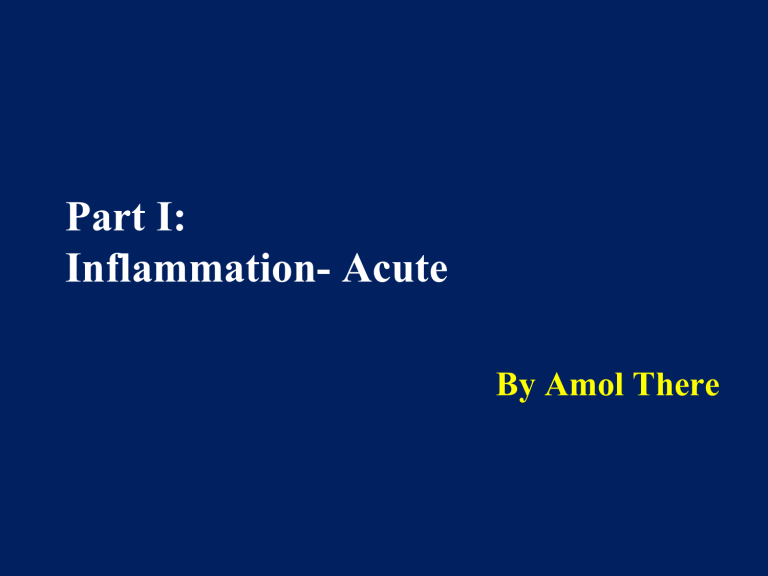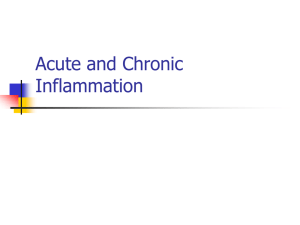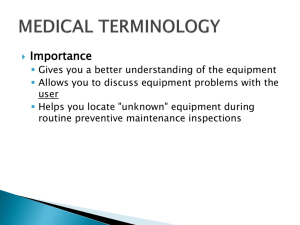
Part I: Inflammation- Acute By Amol There Inflammation Overview • • • • • • Definition Cardinal signs of inflammation Stimuli for acute inflammation Acute vs chronic inflammation Events in acute inflammation Chemical mediators in inflammation Inflammation Is defined as the local response of living mammalian tissue to injury from any agent. It is a body defense reaction in order to eliminate or limit the spread of injurious agents, followed by removal of the necrosal cells and tissue Inflammation_Cardinal Signs 4 cardinal Signs of inflammation: The roman writer celsus in 1st centurary A.D. named the famous signs of inflammation as: --Rubor(redness) --Tumor(swelling) --Calor(heat) --Dolor(pain) Functio laesa(Loss of function) later added by virchow. Inflammation_causes The injurious agents: Infective agents :- bacteria, viruses and their toxins, fungi, parasites. Immunological agents:- cell mediated and antigen-antibody reactions. Physical agents:- heat, cold, radiations mechanical trauma. chemical agents:-organic and inorganic poisons. Inert materials :- as foreign bodies(dirt, splinters, sutures). Tissue necrosis from any cause Inflammation Types Depending upon the defense capacity of the host and duration of response, classified as A. Acute B. Chronic Inflammation- Types A. Acute:- is of short duration( >2 weeks), representing early body reaction, resolve quickly and usually followed by healing. Main features:Accumulation of fluid and plasma at the affected site. Intravascular activation of platelets. Migration of leucocyte-neutrophils. B. Chronic: is of longer duration and occurs after delay, either after the causative agents of acute inflammation persists for a long time or the stimulus is such that it induces chronic inflammation from the beginning. Marked chiefly by the formation of new connective tissue. Inflammation_Acute Inf. Two events: A. Vascular B. Cellular A:- Alteration in the microvasculature(arterioles, capillaries and venules) is the earliest response to tissue injury. These alterations include Hemodynamic changes and changes in vascular permeability. B:- Emigration of leucocyte from the microcirculation and accumulation in the focus of injury(cell recruitment and activation). Inflammation_Acute Inf. A. Vascular Changes: Starling’s Law: Movements of fluid in and out of arterioles, capillaries and venules is regulated by the balance between. 1. Intravascular hydrostatic pressure- tends to force fluid out of vessels 2. Osmotic pressure of the plasma proteins- tends to retain fluid within the vessels. Forces that cause outward movements of fluid from microcirculation; Intravascular Hydrostatic pressure and colloidal osmotic pressure of interstitial fluid. Forces that cause inward movement of interstitial fluid into circulation: Intravasculature colloid osmotic pressure and hydrostatic pressure of interstitial fluid. Inflammation-Acute Pathogenesis Inflammation_Pathogenesis In Inflamed Tissue: There is a accumulation of edema fluid in the interstitial compartment which comes from blood plasma initially the fluid escape due to vasodilation and consequent elevation in hydrostatic pressure. The endothelial lining of microvasculature becomes more leaky. Consequently, intravascular colloid osmotic pressure decreases and osmotic pressure of the interstitial fluid increases resulting in excessive outward flow of fluid into the interstitial compartment which is exudative inflammatory edema. Inflammation_Acute Inf. Inflammation_Pathogenesis Pattern of increased vascular permeability: Increased vascular permeability via non permeable endothelial layer of microvasculature becomes leaky can have following pattern and mechanism. 1. Contraction of endothelial cells: An example of such immediate transient response is mild thermal injury of skin of forearm. 2. Contraction or mild endothelial damage: Classic example of delayed and prolonged leakage is appearance of sunburns mediated by ultraviolet radiation. 3. Direct injury to endothelial cells: The example of immediate sustained leakage are severe bacterial infections while delayed prolonged leakage may occur following moderate thermal injury and radiation injury. 4. Leucocyte- mediated endothelial injury: The example are seen in sites where leucocytes adhere to the vasculature endothelium e.g. in pulmonary venules and capillaries. 5. leakiness in neovascularization: In addition, angiogenesis under the influence of vascular endothelial growth factor during the process of repair and in tumors are excessively leaky. Inflammation_Pathogenesis Cellular Events:- Two processes 1. Exudation of leucocyte 2. Phagocytosis Exudation of leucocytes:-escape of leucocyte from the microvasculature to the interstitial tissue. In acute inflammation, neutrophil comprise the first line defense followed later by the monocyte and macrophages. Changes leading to migration of leucocyte are as follows: Changes in the formed elements of blood ● Rolling and adhesion ● Emigration ● Chemotaxis ● Phagocytosis Inflammation_Pathogenesis Changes in the formed elements of blood :1. Early stage of inflammation , vasodilation progresses but subsequently, there is slowing of blood or stasis of blood stream. 2. the central stream of cells becomes widen and peripheral plasma zone becomes narrower because of loss of plasma by exudation. This phenomenon is known as Margination or peripheral orientation. 3. As a result of this redistribution neutrophil of the central column come to the vessel wall, this known as Pavementing. Inflammation_Pathogenesis Inflammation_Pathogenesis Rolling and Adhesion: Neutrophil slowly roll over the endothelial cells(roll over), followed by transient bond(adhesion phase), cell adhesion molecules which brings rolling and adhesion. Selectin (P,E,L):Expressed on the surface of activated Endothelial cell which brings out the rolling of leucocyte. Integrins : Endothelial cell surface protein, which are activated during the process, loose and transient adhesion between leucocyte and EC. Immunoglobulin: Present on most cells, partake in cell to cell contact through various CAM and cytokines. Inflammation_Pathogenesis Inflammation_Pathogenesis Emigration: 1. After sticking of neutrophil to endothelium, 2. Throw out cytoplasmic pseudopods. - In first 24 h(half life-24-48 h) - Monocyte- Macrophages appear in the next new 24-48 h and survive much longer. Chemotaxis: Transmigration of leucocytes after crossing several barriers (endothelium, basement membrane, perivascular myofibrobalsts and matric) to reach the interstitial tissue is a chemotactic factor mediated process Chemotactic agents for neutophils --Leukotriene B4(LT-B4) --Complement system(C5a and C3 a) --Cytokine(Interleukin, IL-1,8) --Soluble bacterial products(such as formylated peptide) Inflammation_Pathogenesis Inflammation_Pathogenesis Inflammation_Pathogenesis Phagocytosis: is defined as the process of engulfment particulate material by the cells. of solid Neutrophil and macrophages on reaching the tissue spaces produces several proteolytic enzymes- lysozyme, protease, collagenase, elastase, lipase, proteinase, gelatinase and acid hydrolase. Enzyme degrade collagen and extracellular matrix. Phagocytosis of microbe. 1.Recognition and attachment 2.Engulfment 3. Killing and Degradation Inflammation_Pathogenesis 1.Recognition and attachment:- expression of cell surface receptor on macrophages –Mannose and scavenger. Further enhanced by opsonization (microbes coated with opsonins protein from serum) 2.Engulfment:- The opsonized particle or microbe bound to the surface of phagocyte is ready to be engulfed. Pseudopods formation through activation of actin filament- phagocytic vacuole. 3. Killing and Degradation:- phagocytes and scavenger cells function-degradation of microorganism. Inflammation_Pathogenesis Inflamation_Pathogenesis Disposal of micro-organism take pace by two mechanisms A. A. Intracellular Mechanisms B. Extracellular Mechanisms A-Intracellular Mechanisms- intracellular metabolic pathways- by oxidative, common - Less often by non-oxidative 1. Oxidative bactericidal mechanism by oxygen free radicals-oxidative damage by O-2,H2O2,OH-,HOCl,HOBr. Either via Myeloperoxidase or independent. 2. Oxidative bactericidal mechanism by lysosomal granules-preformed granule-stored of neutrophil and macrophages are discharged into the phagosome and extracellular environment. 3. Non-oxidative bactericidal mechanism-. some agents released from phagocytic cell do not require oxygen for bactricidal activity- Nitric oxide. Inflammation_Pathogenesis Inflammation_Pathogenesis B. Extracellular: i)Granules- Degranulation of macrophages and neutrophil –exerts effects of proteolysis outside the cells as well apart to above. ii) Immune mechanism- immune- mediated lysis of microbe take place outside the cells by mechanism ------Cytolysis ------Antibody-mediated lysis -------By cell-mediated cytotoxicity. Inflammation Inflammatory Mediators Inflammation_Mediators Mediators of inflammation - release to certain stimuli- may be injurious agents, dead cell, damaged cell. 1) Cell derived mediators A. Vasoactive amines 2)Plasma protein derived mediators (plasma proteases) A. Kinin system B. Arachidonic acid metabolite C. Lysosomal components B. Clotting System D. Platelet Activating Factor C. Fibrinogen System E. Cytokines D. Complement Cascade F. Free radicals Inflammation_Mediators Mediators of inflammation - release to certain stimuli- may be injurious agents, dead cell, damaged cell. Two types 1) Cell derived mediators 2) Plasma protein derived mediators(plasma proteases) 1) Cell derived mediators are:A. Vasoactive mediators 1. Histamine-granules in mast cell, basophil and platelet. 2. 5_HT-tissue like chromaffin cell of GIT, NT, mast cell & platelet. 3. Neuropeptides-Substance P, Neurokinin, VIP and somatostatin. Inflammation_Mediators B. Arachidonic acid metabolite – Arachidonic acid Derived from cell membrane by phospholipase. It is then activated to archidonic acid metabolite by two pathways 1. cyclooxygenase pathway: Cell membrane ( phospholipid)-----→Archidonic acid -------- PGG2PL ase COX1,2 -----→PGH2-------→ 3 metabolite a) Prostaglandin(PGD2,PGE2,PGF2-alpha) b) Thrombooxane A2 c) Prostacyclin Inflammation_Mediators 2. Metabolite via lipo oxygenase pathway: 5-HETE, leukotrienes Lipooxgenase in neutrophil act on Arachinodic acid---→5-HPETE-→peroxidation to form 3 metabolites------5-HETE(CT agent), leukotrienes A4----LTB4(CT and cell adherence), LTC4, LTD4, and LTE4common action by causing smooth muscle contraction and thereby induce vasoconstriction, broncho-constriction and increased vascular permeability. 3.Lipoxin-regulate and counterbalance action of LT A. Inflammation_Mediators Inflammation_Mediators C. Lysosomal components:- the inflammatory cells-neutrophil and monocyte, contain lysosomal granules 1. Granules of neutrophil- 3 types of granule- 1ary,2ndary and 3tiary 2. granules of monocyte and tissue macrophages-on degranulation release proteases, collagenase, elastase and plasminogen activator. D. Platelet Activating Factor(PAF)-IgE-sensitised basophil or mast cell, leucocyte, endothelium and platelet. Apart to platelet aggregation, PAF as mediator of inflammation are: ● ● ● ● ● Increase vascular permeability Vasodilation in low con and vasoconstriction bronchoconstriction Adhesion of leucocyte to endothelium Chemotaxis. Inflammation_Mediators E. Cytokines- polypeptide substances produced by activated lymphocyte and activated monocyte i. Interleukins(IL-1,6,8,12,17)1.IL-1 and 6 are active in mediating acute inflammation 2.IL-12 and 17 a potent role in chronic inflammation 3.IL-8 chemotactic for acute inflammatory cells ii. Tumor necrosis factor (TNF-α and β)- former is a mediator of acute inflammation and latter is involved in cellular toxicity and in development of spleen and lymph node. TNF gama- it is produced by T cells and NK cells and act on all cell. it acts as mediator of acute inflammation. iii. Other chemokine- IL-8 MCP-1 PF-4 Inflammation_Mediators Inflammation_Mediators F. Free radicals: oxygen metabolites and nitric oxide: free radicals acts as potent mediator of inflammation. i. Oxygen derived metabolites are released from activated neutrophil and macrophages and include superoxide oxygen O-2, H2O2,OH- and toxic NO. Action of inflammation as follows: ----Endothelial cell damage and thereby increased vascular permeability. ---Activation of protease and inactivation of antiprotease causing tissue damage. ----Damage to other cell. ii. NO- role in mediating inflammation -- vasodilation -- antiplatelet activating agent -- possibly microbicidal action. Inflammation_Mediators Inflammation_Mediators B. Plasma Proteins-Derived mediators These include four systems: Kinin, clotting, fibrinogen and complement All linked by initial activation of hageman factor XIIa 1. The Kinin System: XIIa generated bradykinin, slow contraction produced of smooth muscle . Acts in early stage of inflammation. ● ● ● ● Smooth muscle contraction Vasodilation Increased vascular permeability Pain Inflammation_Mediators 2. Clotting system: factor XIIa initiate the cascade of clotting system resulting in formation of fibrinogen which is acted upon by thrombin to form fibrin. The action of fibrinopeptides in inflammation are: ● Increased vascular permeability ● Chemotaxis for leucocyte ● Anticoagulant activity. Inflammation_Mediators 3. Fibrinolytic System:- This system activated by plasminogen activator, The source of which include kallikrein of the kinin system, endothelial cells and leucocytes. The action of plasmin in inflammation are as follows: i) Activation factor XII to form prekallilrein activator that stimulate the kinin system to generate bradykinin. ii) Split of complement C3 to C3a which is a permeability factor iii) Degrades fibrin to form fibrin split product. Inflamation_Mediators 4. The complement system: activation of complement system can occur either i. Classic pathway through antigen-antibody complex ii. Alternate pathway nonimunologic agent such as bacteria, toxin , cobra venom and IgA. Yields of the activation of these pathways which include anaphylatoxin(c3a,C4a and c5a) and membrane attack complex(MAC) ie.C5b,C6,7,8,9 Inflamation_Mediators The action of Activated complement system in inflammation: i. C3a, C5a,C4a-activate mast cell and basophil-----cause release of VA amines--cause increased vascular permeability--cause edema---augments phagocytosis. ii. C3b is an opsonin iii. C5a is chemotactic for leucocyte. iv. Membrane attack complex is lipid dissolving agent and cause hole in phospholipd membrane. Inflamation_Mediators Factor XII Thanks! Questions? Thanks! Questions? Thanks! Questions? • Which of the complement components act as chemokines? A. C3b B. C4b C. C5a D. C4a • The following adhesion molecules play a significant role in rolling of PMNs over endothelial cells except. A. Selectins B. Integrins C. Opsonins D. Immunoglobulin molecules Thanks! Questions? Part II: Chronic Inflammation By Amol There Inflammation-Chronic Prolonged process in which tissue destruction and inflammation occur at the same time. Chronic inflammation may occur by one of the following 3 ways. 1. Chronic inflammation following acute inflammation 2. Recurrent attacks of acute inflammation 3. Chronic inflammation starting de novo Inflammation-Chronic 1. Chronic inflammation following acute inflammation --- when tissue destruction is extensive or bacteria survive and persist in small no. at the site of acute inflammation e.g. osteomylitis, Pneumonia terminating in lung abscess 2.Recurrent attacks- when repeated bouts of acute infection culminate in chronicity of the process e,g. chronic pyelonephritis due to repeated urinary tract infection. 3. De novo--- when the infection with organism of low pathogenecity is chronic from the beginning e.g, infection with mycobacterium tuberculosis. Inflammation-Chronic General feature of chronic inflammation: there are some basic similarities amongst various types of chronic inflammation. 1. Mononuclear cell infiltration :infiltrated by mononuclear cells like phagocyte and lymphoid cell. Monocyte--- to macrophages (beside phagocytosis) ---- further activated by cytokine. Other cells are lymphocyte, plasma cell, eosinophil and bacterial toxin Inflammation-Chronic 2. Tissue Destruction or necrosis: brought about by activated macrophages which release a variety of bilogical active substances. 3. Proliferative changes:As a results of necrosis, of small blood vessel and fibroblasts is stimulated resulting in formation of inflammatory granulation tissue. Finally, healing by fibrosis and collagen laying take place Inflammation-Chronic Systemic effect of chronic inflammation: 1. 2. 3. 4. 5. Fever Anaemia Leucocytosis ESR is elevated Amyloidosis Types of chronic inflammation 1. Chronic non-specific inflammation 2. Chronic granulomatous Inflammation-Chronic Types of chronic inflammation 1. Chronic non-specific inflammation when the irritant substance produces a non- specific chronic inflammatory reaction with formation of granulation tissue and healing by fibrosis. Ex. Chronic osteomyelitis, chronic ulcer, lung abscess. 2. Chronic granulomatous inflammation: in this, the injurious agent causes a characteristic histological tissue response by formation of granulomas Ex. tuberculosis, leprosy, syphilis, sarcoidosis etc. Inflammation-Pathogenesis Granulomatous inflammation: Defined as circumscribed tiny lesion of 1 mm in diameter, composed mainly of modified macrophages called epitheloid cells, and rimmed at the periphery by lymphoid cells. Pathogenesis: -Formation of granuloma is type IV granulomatous hypersensitivity reaction. -protective defense reaction by the host but eventually causes tissue destruction because of persistence of the poorly digestible antigen e.g. mycobacterium tuberculosis, M. leprae. Inflammation-Pathogenesis Sequence in evolution of granuloma is outlined below: 1. Engulfment by macrophage 2. CD4 + T cells 3. Cytokines 1. Engulfment by Macrophages:- macrophages and monocyte engulf antigen and try to destroy it. 2. CD4 + T cell – macrophages, being antigen presenting cells, fail to deal with antigen, present to the CD4 + T lymphocyte. 3. Cytokines- formed by the activated CD4 + t cells and also by activated macrophges . Inflammation-Pathogenesis Cytokine roles 1. IL-1 & 2 stimulate proliferation of more T cells. 2. Interferon- gamma activates macrophages. 3. TNF-α promotes fibroblast proliferation and activates endothelium to secrete prostaglandin, which have role in vascular response in inflammation. 4. growth factors (Platelet- derived growth factor) elaborate by macrophages stimulate fibroblasts growth. Inflammation-Fate Ganuloma formed having macrophage modified as epitheloid cells in the center, with some interspersed multinucleate giant cells surrounded periphery by lymphocyte and healing by fibroblasts or collagen Inflammation Inflammation Q. Formation of granuloma is A.Type I hypersensitivity B. Type II hypersensitivity C.Type III hypersensitivity D. Type IV hypersensitivity Part III: Basic Principles of Wound Healing in Skin By Amol W. There





